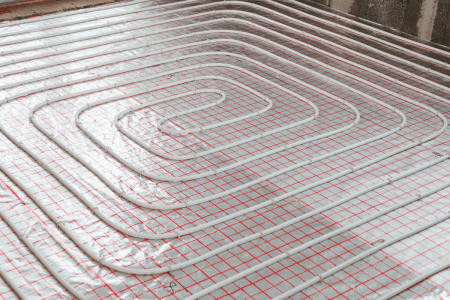Hydronic heating can take up to 15 minutes to heat up a room, but it will vary. It depends on the size of your room, the material of your walls and floors, and the type of hydronic heating system you may have installed.
Confused? Let’s then look at a few of the factors in detail.
All of us know that larger rooms take longer to heat up than smaller ones. Larger spaces have more stale air that forces the heater to work for a few extra minutes to raise the room temperature to a comfortable level.
This isn’t the only factor that affects how long hydronic heating takes to heat up your room.
The type of hydronic heating system you have installed will also impact the heating time. Radiant heating systems, for instance, take longer than baseboard heaters or forced air heaters to warm up.
Read on and we’ll explain more about how hydronic heating works and what affects how long it takes hydronic heating to warm up a room.
How Hydronic Heat Works
Hydronic heating works by heating water in a boiler and circulating it throughout the home.
It works through a network of pipes that carries hot water from the boiler to underfloor heating systems, wall-mounted radiators, or convectors. These systems then radiate the water’s heat into your room.
Also there is a pump that is responsible for circulating water through the pipes. Hydronic heating systems also have a thermostat to let you set the room temperature. Some thermostats offer zone control, too, allowing you to heat only the rooms you’re using.
Heat Transfer in Hydronic Systems
Hydronic floor heating systems transfer heat via thermal radiation. It is the transfer of heat via electromagnetic waves that are full of energy. When hydronic systems emit these waves, they will leave the system and start colliding with objects in your room.
These objects, which may include walls, chairs, floor, ceiling, will then absorb the radiant heat. This will force their temperature to go up, with your room temperature following suit. This is precisely why heat generated by hydronic systems cannot be moved or blown away.
Components of a Hydronic Heating System
Here are the components of a hydronic floor heating system:
Boiler: The boiler is responsible for heating water using fuels, including LPG, natural gas, diesel, electricity or even wood pellets. You can control the boiler’s temperature via a thermostat.
Piping: The piping is what carries hot water towards one of the hydronic heating systems. It is also responsible for carrying cold water to the boiler for reheating and is mainly made of plastic or copper.
Pump: The pump is one of the most crucial components of a hydronic heating system. It is responsible for carrying water through the pipes. It transfers cold water to the boiler, and hot water to one of the three heating systems described below.
Heating System: Available in the form of convectors, radiators or underfloor heating system, it is responsible for introducing the water’s heat to the room. The type which will work best for you depends on your home’s layout.
Thermostat: A radiant heat thermostat lets you control the heat level to set your home temperature. Some of the high-end radiant heat thermostats also give the option of zone control.
Which Hydronic Heating System Heats Up The Fastest?
How long do radiators take to heat up?
Radiators will heat up your room faster than convectors or underfloor hydronic heating systems. That’s because they usually cover a small heated area (compared to underfloor heaters) and that too at a much higher temperature. This allows radiators to heat up their surroundings quickly.
Some radiators heat up even faster.
Called forced-air radiators, these units use a blower to transfer the water’s heat to the surrounding area. This allows the room to heat up much quicker, provided its not too big of a room.
How long does radiant heat take to warm up?
Radiant heat can take as little as 30 minutes, and up to a day or two to warm up. It depends on the size of your room, floor construction, and type of radiant heat system.
Hydronic Heating Costs
An average hydronic heating system’s installation cost is 2 to 3 times higher than that of a ducted heating system. However, don’t just look at the initial costs.
Over time, these units will save you money because they run more efficiently. Most of them run on 2/3rd of the power it takes to operate a ducted heating system.
Here are the installation costs of different hydronic heating systems:
Hydronic Underfloor Heating Cost: The installation cost of a hydronic underfloor heater ranges between $10 and $16. That means you may have to fork out around $600 for a standard remodeling project.
Hydronic Radiator Heater Cost: The installation cost of a natural gas hydronic radiator heater hovers around the $1,300 mark. That includes the cost of the radiator, labor cost and the cost of the boiler for a standard size home.
Hydronic Baseboard Heater Cost: A good hydronic baseboard heater will set you back between $200 and $250 in terms of installation.
How Efficient is Hydronic Heating?
The energy efficiency of a hydronic heating system is about 90%. To put this in perspective, forced air heating systems have a thermal efficiency of less than 50%. This is one of the main differences between hydronic and forced air systems.
Factors that affect hydronic heating systems’ efficiency
The efficiency of hydronic heating systems depends on the following factors:
Leakages in pipes and heating ducts: Hydronic heating systems with leakages or tiny-sized holes in their ductwork will consume more energy than those with watertight duct systems.
Efficiency of pump and blower: Centrifugal pumps are less efficient than positive displacement pumps, especially when they have to deal with high-head/low flow service, which forces them to work harder.
Type of hydronic heating system: Radiant heating systems are much less efficient than baseboard heaters because they waste more heat. Baseboard heaters, meanwhile are worse than underfloor heating systems in terms of efficiency.
Thermal mass of your floors: This is the capacity of your room’s floor to absorb and store energy. Heavyweight materials like brick, tiles and concrete have a greater thermal mass than lightweight ones such as timber. In short, denser materials will store heat better.
Types of Heaters for Hydronic Heat Systems
Tankless water heaters have pros and cons that you should consider. But they are generally popular because they supply endless hot water while saving energy and taking up less space.
Anyway, here are the different types of heaters hydronic systems use to heat water:
Tankless Water Heater
Tankless water heaters does not rely on a storage tank to heat water. They pass cold water through pipes and raise its temperature using either electricity or a gas burner. This allows tankless water heaters to deliver an endless supply of hot water.
Pros of Tankless Water Heaters
Tankless water heaters don’t suffer from standby heat losses, are between 8% and 50% more efficient than tank-style heaters and deliver a never-ending supply of hot water. They also occupy less space.
Cons of Tankless Water Heaters
One of the major downsides of tankless water heaters is that their initial costs (unit and installation) are often higher than those of storage-tank style heaters. Also, tankless water heaters won’t get to work unless your hot water demand is above their actuation level.
Solar Water Heater
Solar water heaters use sunlight’s thermal energy to heat water. They work by deflecting sun rays to water present in a storage tank, where their thermal energy will increase the water’s temperature. Here are the pros and cons of solar water heaters.
Pros of Solar Water Heaters
Solar water heaters have minimal running costs, require little maintenance besides the weekly cleaning of their panels and have zero impact on your power bills. Most of them are backed with 20- to 30-year warranties too, which means you can keep on using them for decades to come.
Cons of Solar Water Heaters
Some people steer clear of using solar water heaters because they aren’t helpful in areas that don’t receive regular sunlight, especially in winter. Aside from that, their batteries do not come cheap and you have to have ample space on your roof to store solar panels.
Heat Pump
Heat pumps capture heat from their surroundings, transmit it to their coolant and raises its temperature. This forces the coolant to compress. The heat pump then passes cold air it has captured from your room over the coolant. This will raise the air temperature in your room.
Pros of Heat Pumps
Heat pumps have small upfront costs, are incredibly easy to install and are simple to operate. You can troubleshoot most problems on your own. They are also an excellent option to have as long as the area you’re trying to heat is small.
Cons of Heat Pumps
Heat pumps aren’t a good heating option for underfloor or slab heating. Their efficiency levels are lower compared to tankless water heaters or solar panels. That is why we think they should only be used for heating small spaces.
Combi Boiler
Combi boilers work by drawing in water from the mains, igniting the gas burner and using the burner’s heat to raise water temperature. Their working mechanism allows combi boilers to deliver hot water on demand, similar to a tankless water heater.
Pros of Combi Boiler
Combi boilers deliver hot water on demand, require no cylinders or additional tanks and can therefore be installed in your average-sized kitchen cupboard. Most of them have an efficiency rating of over 90% and save you on energy bills.
Cons of Combi Boiler
Combi boilers’ water output declines if more than one appliances need hot water simultaneously. They only work at their optimum level if your mains pressure is excellent. And the absence of a storage tank means you may be left without any heating if the boiler breaks down.
Conclusion
We hope this guide has been helpful in explaining the factors the affect how long it takes your radiant heat to warm up. Not only is room size important, but also things like the type of hydronic system you choose to install.

I graduated with a degree in Chemical Engineering and have written for a number of nationally recognized publications in the home improvement space. My skills include fluid mechanics and process engineering and I have worked on numerous projects, including in waste water flow rate calculation and heat balance of steam rollers in the paper industry. My goal as a technical writer is to make complicated topics easy to understand for the average person.
